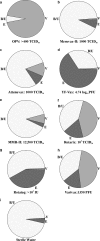Viral nucleic acids in live-attenuated vaccines: detection of minority variants and an adventitious virus
- PMID: 20375174
- PMCID: PMC2876658
- DOI: 10.1128/JVI.02690-09
Viral nucleic acids in live-attenuated vaccines: detection of minority variants and an adventitious virus
Abstract
Metagenomics and a panmicrobial microarray were used to examine eight live-attenuated viral vaccines. Viral nucleic acids in trivalent oral poliovirus (OPV), rubella, measles, yellow fever, varicella-zoster, multivalent measles/mumps/rubella, and two rotavirus live vaccines were partially purified, randomly amplified, and pyrosequenced. Over half a million sequence reads were generated covering from 20 to 99% of the attenuated viral genomes at depths reaching up to 8,000 reads per nucleotides. Mutations and minority variants, relative to vaccine strains, not known to affect attenuation were detected in OPV, mumps virus, and varicella-zoster virus. The anticipated detection of endogenous retroviral sequences from the producer avian and primate cells was confirmed. Avian leukosis virus (ALV), previously shown to be noninfectious for humans, was present as RNA in viral particles, while simian retrovirus (SRV) was present as genetically defective DNA. Rotarix, an orally administered rotavirus vaccine, contained porcine circovirus-1 (PCV1), a highly prevalent nonpathogenic pig virus, which has not been shown to be infectious in humans. Hybridization of vaccine nucleic acids to a panmicrobial microarray confirmed the presence of endogenous retroviral and PCV1 nucleic acids. Deep sequencing and microarrays can therefore detect attenuated virus sequence changes, minority variants, and adventitious viruses and help maintain the current safety record of live-attenuated viral vaccines.
Figures


References
-
- Allan, G. M., D. P. Mackie, J. McNair, B. M. Adair, and M. S. McNulty. 1994. Production, preliminary characterisation and applications of monoclonal antibodies to porcine circovirus. Vet. Immunol. Immunopathol. 43:357-371. - PubMed
-
- Allan, G. M., F. McNeilly, I. McNair, M. D. Curran, I. Walker, J. Ellis, C. Konoby, S. Kennedy, and B. Meehan. 2000. Absence of evidence for porcine circovirus type 2 in cattle and humans, and lack of seroconversion or lesions in experimentally infected sheep. Arch. Virol. 145:853-857. - PubMed
-
- Allan, G. M., K. V. Phenix, D. Todd, and M. S. McNulty. 1994. Some biological and physico-chemical properties of porcine circovirus. Zentralbl. Veterinarmed. B 41:17-26. - PubMed
-
- Allen, A. 2007. Vaccine: the controversial story of medicine's greatest lifesaver. W.W. Norton, New York, NY.
Publication types
MeSH terms
Substances
Associated data
- Actions
- Actions
Grants and funding
LinkOut - more resources
Full Text Sources
Other Literature Sources
Medical

